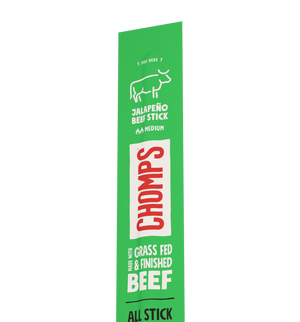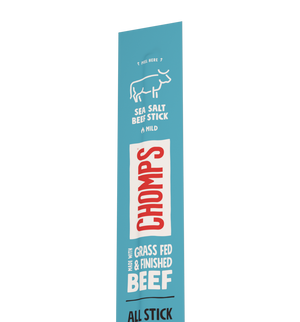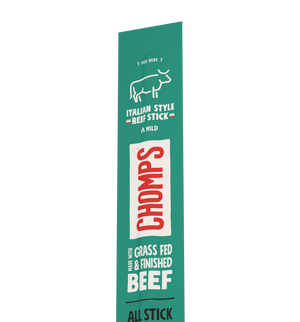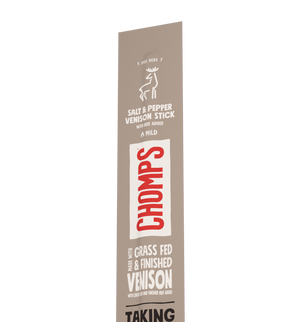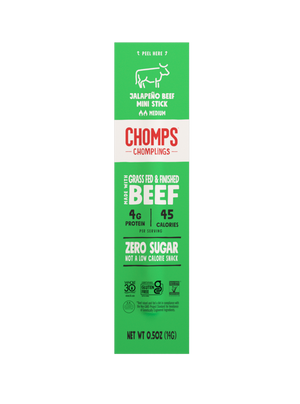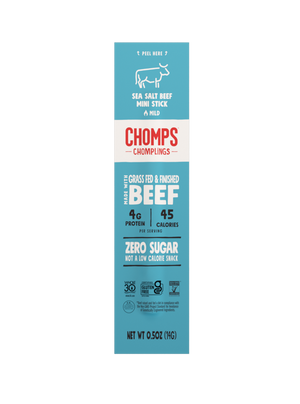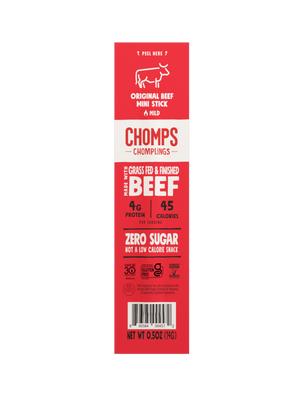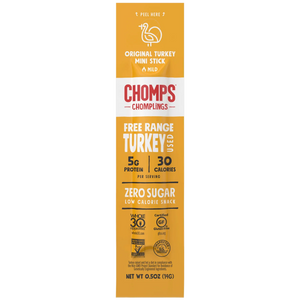At Chomps, we use only grass-fed and grass-finished beef in our meat sticks. You may be wondering why we made this choice. What’s the difference between grass-fed and grain-fed beef and why do we believe grass-fed is better?
Grass-fed beef comes from cows that eat grass, whereas grain-fed beef eats a diet of soy and/or corn. Grains are not the natural food of cows, but are a quick way to get them to fatten up. While grain-fed cows produce more meat in a shorter time, feeding grains to cows significantly changes the taste and nutritional profile of beef, and not in a good way.
Here’s the breakdown of the differences between grass-fed and grain-fed beef and why we choose to use grass-fed in our beef products.
The Difference Between Grass-Fed and Grain-Fed Beef
As we mentioned, the main difference between grass-fed vs grain-fed beef is what the cows eat. Grain feeding is common in countries like the United States, where beef is mass-produced. In other countries, like New Zealand, grass-fed beef is more common.
Grain-fed cows often start their lives roaming free on a pasture, able to eat grasses and other available plants. At around 9 months old, they are moved to a feedlot called a concentrated animal feeding operation (CAFO), where they are kept in tight spaces and given grain-based feed to help fatten them up. This feed is typically made from soy or corn. They live in the CAFO for a few months until they are ready for slaughter.
Grass-fed cows, on the other hand, are fed mostly grass. Since grass has fewer calories than grain, it takes longer for the cows to be ready for slaughter, which is about 24 months. Also, they tend to weigh less than feedlot cows due to the difference in their diet.
Still, this doesn’t necessarily mean they are free to roam on pastures. Since this term is not well-defined, the living environment of these cows may not be that different from those that are grain-fed.
The type of diet cows are fed has a significant impact on the nutritional profile and taste of the beef.
Nutritional Profiles of Grass-Fed Beef vs Grain-Fed Beef
What a cow eats changes the nutritional composition of the beef that you eventually eat. Both grass-fed and grain-fed beef are good sources of protein, iron, B vitamins, selenium, and zinc. Grass-fed beef has more fat-soluble vitamins, particularly vitamin A, vitamin E, and certain antioxidants.
While grass-fed beef is slightly more nutritious than grain-fed, the main area where they differ is in the amount and type of fat they contain. Grass-fed beef has less total fat (and therefore fewer calories) than grain-fed per serving. This makes sense since the grain is used to fatten up the cows, beyond their normal weight.
The kind of fat in both types of beef is also different. Grass-fed beef is a richer source of healthy fats, such as omega-3s and conjugated linoleic acid (CLAs). Omega-3s are well known for their heart and brain health benefits, helping lower inflammation. CLA may play a role in
weight management and has benefits for heart and bone health.
How do Grass-Fed and Grain-Fed Beef Flavor and Quality Compare?
What about the flavor of the finished product? Does grass-fed beef taste different?
Grain-fed beef tends to be more marbled and fattier than grass-fed. Marbling, or the fat in the beef, increases the richness of the taste and texture of the beef. Corn-fed beef may also have a slightly sweeter taste.
Grass-fed beef has less marbling than beef that is fed corn or soy. Due to the lower fat content, it may be slightly tougher or drier. It may also have a stronger mineral flavor that may taste more gamey or meatier than grain-fed.
While the taste of grass-fed beef may be slightly different from grain-fed, the health profile is what makes it a superior choice.
Which of Grass-Fed vs. Grain-Fed is Worth the Price?
Grass-fed beef is typically more expensive than grain-fed since it takes longer for the cattle to be ready for slaughter. It may also be more challenging to find, as some traditional grocery stores don’t carry grass-fed beef.
Whether the extra cost is worth it depends on your goals and preferences. Grass-fed beef is a great source of omega-3s, which may be a good option for people who don’t eat fish or other seafood. It can also be a good choice for those trying to still enjoy beef while lowering their total fat intake since it is lower in fat.
Since our mission at Chomps is to offer the highest quality product, we use only grass-fed and grass-finished beef in our meat sticks. Choosing the highest quality meat for our products also aligns with our environmental goals as a brand.
Environmental Impact of Grass-Fed vs Grain-Fed Beef
What about the environmental impact of how beef is raised? It is well-known that traditionally raised cows contribute to increased greenhouse emissions, negatively impact the soil, and pollute local water. In contrast, grass-fed systems contribute to improving the soil by returning nutrients through manure and therefore maintaining a healthier ecosystem.
Healthier grass, with deeper roots, also prevents erosion of the soil. A grass-fed system improves the nutritional content of both the animals and plants. Another benefit is that grass can trap carbon dioxide which helps reduce the amount of greenhouse gasses in the atmosphere, improving the environment overall.
The issue of environmental impact is not black and white. Grass-fed cows live longer to produce the same amount of meat, producing more methane (a greenhouse gas) over their lifetime. However, one study found that the grass on a grass-fed farm stored enough carbon to offset any methane emissions by the cows.
The Bottom Line
The choice between grass-fed and grain-fed beef influences the nutritional profile, flavor, and environmental footprint of the final product. Grass-fed beef, which we use in all of our beef sticks at Chomps, offers more nutritional benefits and is better for the environment.
The health benefits and positive environmental impacts of grass-fed beef align with our commitment to quality and sustainability. By choosing grass-fed and grass-finished beef, we aim to provide a product that supports your personal health and the well-being of our planet.

